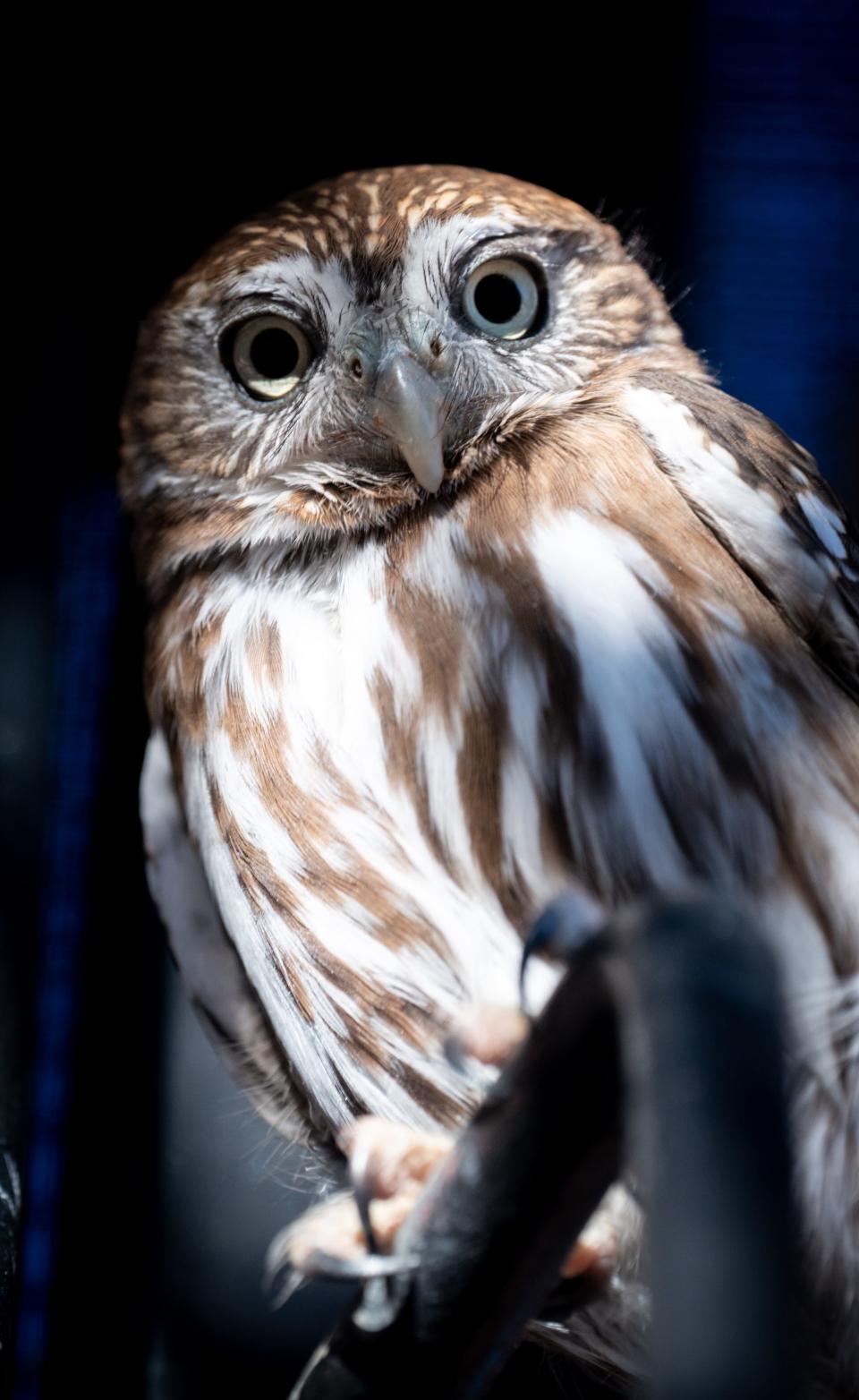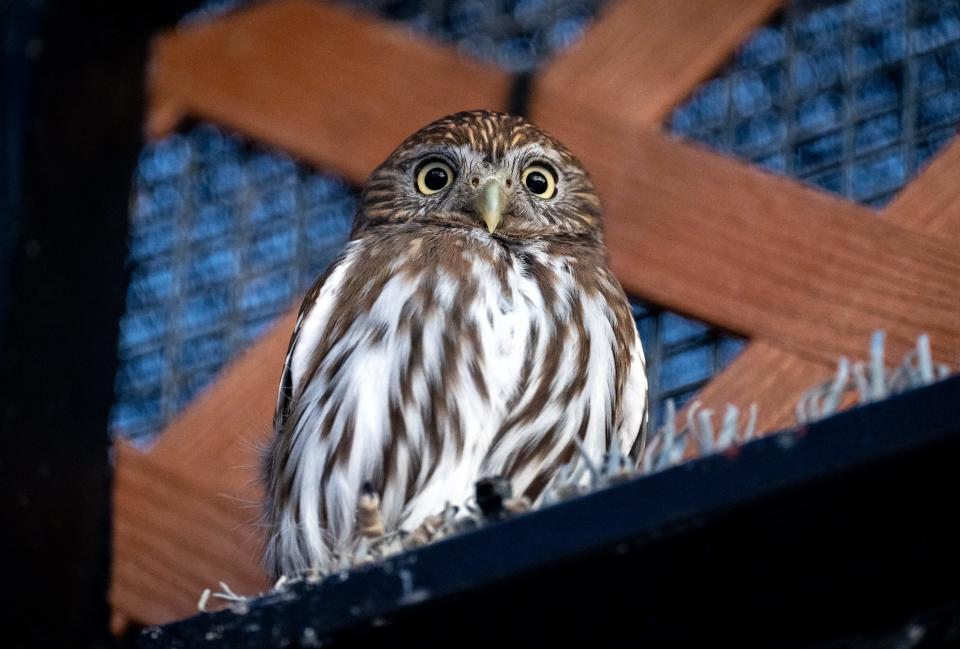Wildlife agency restores protection for Arizona's cactus pygmy-owl after long legal battle
Arizona's pygmy-owl will once more be protected under the Endangered Species Act.
The U.S. Fish and Wildlife Service said Wednesday it would list the cactus ferruginous pygmy-owl as a threatened subspecies. The decision comes after nearly 17 years of legal battles to restore protection for the bird.
This pygmy-owl, a subspecies of the more widespread ferruginous pygmy-owl, is a 6- to 7-inch tall predator that inhabits portions of the Sonoran Desert, the south of Texas, and northeast and northwest of Mexico. In Arizona, the population of pygmy-owls, which are not migratory, declined close to extinction. The state currently has the smallest population of all territories.
The tiny raptor has been under federal protection on-and-off. The federal agency said it's "likely to become an endangered species in the foreseeable future."
In the last century, it fully disappeared from areas of Arizona and Texas that used to be part of its original territory, mainly due to urbanization. By 1997, biologists counted only 35 individual birds in Arizona.

That year the Fish and Wildlife Service declared the subspecies threatened, but homebuilders pushed back, arguing that protection in Arizona was not needed for the species to survive, given that it's also present in Texas and Mexico. The agency revoked the threatened status in 2006. Conservation groups, including the Center for Biological Diversity and Defenders of Wildlife, petitioned the agency to relist it and filed a lawsuit.
“The fierce little cactus ferruginous pygmy-owl needs our care and protection and after a long fight it finally got it,” said Noah Greenwald, endangered species director at the Center for Biological Diversity. "But it shouldn’t have taken this long or required multiple lawsuits to get here."
The nonprofit filed another lawsuit last month because the agency was six months past its legal deadline to list the bird.
Greenwald added that the federal agency is "badly broken" and needs new leadership to get back to "efficiently protecting species and addressing the extinction crisis.”
Imperiled species: 4 pygmy-owls hatch at Phoenix Zoo as part of conservation program
Conservation status and land use

Despite the loss of federal protection, efforts to protect the population of pygmy-owls in Arizona has continued.
The 1997 listing of the pygmy-owl "created uncertainty about where and how (Pima County) could grow," said Adelita Grijalva, who chairs the Pima County Board of Supervisors.
In the early 2000s, the supervisors created the Sonoran Desert Conservation Plan, a regional plan to balance development with natural and cultural resources conservation, and a Multi-Species Conservation Plan to comply with the Endangered Species Act. The county now owns more than a quarter million acres of sensitive lands.
With these plans, the listing of the pygmy-owl as threatened "will not result in land-use battles like those of the 1990s and early 2000s," Grijalva added.
"The pygmy owl will merely join the list of other endangered and threatened species whose habitat the people of Pima County protect and preserve through their Sonoran Desert Conservation Plan.”
The potential range of the bird includes Pima, Santa Cruz, Cochise and Yuma counties, though most of the observed nests are in the Altar Valley, northeast from Sasabe, as well as the Tohono O'odham Nation lands and Avra Valley. The Altar Valley Conservation Alliance, a collaborative organization of ranchers that works for watershed health and good land management practices, also developed a plan to contribute to the enhancement of pygmy-owl habitats.
Saguaros and mesquite woodlands are the primary habitat for the tiny raptor in Arizona.
In Sonora, Mexico, the owl populations are in "notable decline," although they are higher than those in Arizona, according to the USFWS analysis. In Texas, the pygmy-owl population is in the high hundreds and is "somewhat genetically isolated from the rest," according to the agency. This gives this population some resiliency. Areas in northeast and northwest Mexico have an estimated "tens of thousands of pygmy-owls."
Defining critical habitat for the owl
The first time the species was listed, the federal wildlife agency identified 731,712 acres of land in southern Arizona as pygmy-owl critical habitat, mostly by the side of streams, mesquite thickets, woodlands and desert scrub.
The agency said its biologists will propose new designated critical habitat "at a later date."
The designation is a "legal requirement that is not supposed to be delayed but may be," Greenwald told The Republic.
One of the changes that come with the listing is that Fish and Wildlife Service is required to develop a recovery plan for the species. The listing also provides additional protections against development where pygmy-owls live or in areas designated as critical habitat, and freezes up federal dollars for conservation under Section 6 of the Endangered Species Acts he added.
The Arizona Game and Fish Department opposed the listing during the public comment period, and added that it also opposed “any designation of critical habitat.”
“The designation of critical habitat will add undue regulatory burden on the Department and partners current and future conservation actions and increase regulatory burden for private landowners within the designated critical habitat area,” wrote the agency’s Assistant Director of Wildlife Management Division Clay Crowder.
Clara Migoya covers environmental issues for The Arizona Republic and azcentral. Send tips or questions to clara.migoya@arizonarepublic.com.
Environmental coverage on azcentral.com and in The Arizona Republic is supported by a grant from the Nina Mason Pulliam Charitable Trust. Follow The Republic environmental reporting team at environment.azcentral.com and @azcenvironment on Facebook, Twitter and Instagram.
You can support environmental journalism in Arizona by subscribing to azcentral today.
This article originally appeared on Arizona Republic: USFWS renews protections for cactus ferruginous pygmy-owl

